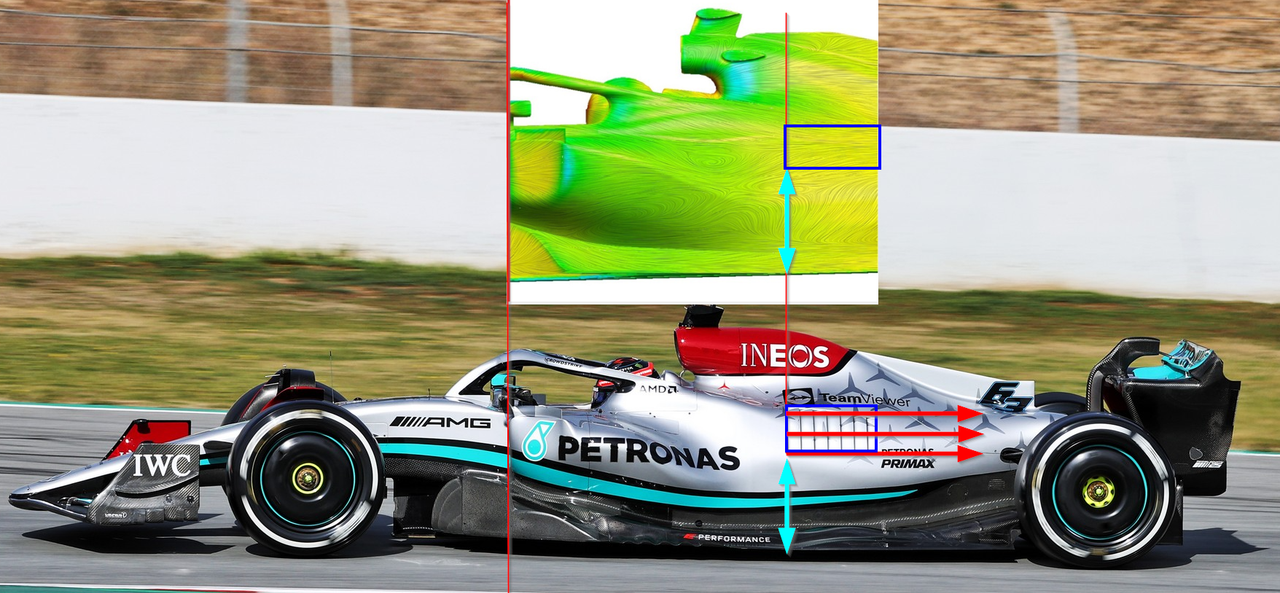How wrong? Quantify. Do you believe having an offset of 10mm on a sidepod of a 2000mm wide car can cause (or not cause) massive changes in overall major turublence structures? Let's see try something:NoDivergence wrote: ↑23 Feb 2022, 21:38I mean, your Merc W13 sidepod geometry is just wrong. Everything behind the inlet is different. The amount of downwash, the amount of outwash from the floor strakes, wavy floor exit, not having the right vortex flows from the front wing, etc etc. All of these have downstream effects that you're trying to make as simple as, oh the flow hits the tire and the rear wing has less downforce now.

Geometry just wrong? Hardly. Btw, do you have any idea how hard it is to achieve the corellation of that circled bottom separation?!? (I'd like to ask everyone to let NoDivergence answer this first, please. K thx)
Angular velocity is 138.9 rad/s. Does that mean anything to you without the free-stream velocity? That's kind of where things starts, isn't it?NoDivergence wrote: ↑23 Feb 2022, 21:38What angular velocity do you have the tires at in this model? And at what camber/castor/tire deformation geometry (which is a function of load)? Do you have the W13's reverse rake modeled?
What is the function of icluding tyre deformation? How can this be quantified? How can I guess this and is using my guess of any worth for this area? Or is it only worthy when using actual factual data which only teams and Pirelli have?
No, they can't. I'm not making any claims about floor performance for Heaven's sake...NoDivergence wrote: ↑23 Feb 2022, 21:38All kinds of small details that can impact virtually everything of conclusion that you're trying to state
Bold part - Yes they are, they really are. When you are chasing a few more df points. I'm not chasing any df points really.NoDivergence wrote: ↑24 Feb 2022, 08:36You may think that 10 times bigger may be sufficient to be statistically significant, but given that I'm 100% confident that your flow field is not accurate (front wing flow structure, bargeboard/vane/brake duct/floor geometry, sidepod geometry, etc, I wouldn't make any kind of claim if I were you. Vortex flow and wake management is the most complex part of these car's designs and have massive effects on the end results. I wouldn't be surprised if there was over 10% CDA difference between a completely unoptimized design like yours.(using standardized floor, wing, nose, etc letting the flo flow hit whatever it hits instead of being targeted and positioned) and something like what the W13 has, even in this testing state.
I wouldn't be surprised if there was even 15-20% CDA difference between this model and actual car. That doesn't mean that one model forming a structure the other isn't (and has no way of forming on the real car), causing a substantial difference in drag value, isn't a significant and telling sign.
Move the outwash a couple of inches within these regulations and teams will hire you instantly!NoDivergence wrote: ↑24 Feb 2022, 08:36PS, one of the reasons for the amount of cranked front wing on the W13 is likely to maximize the amount of spanwise flow to power these vortices.
The concept of the sidepod cannot be separated from the optimizations intended to position these vortices and flow structures.
You mean to tell me that if I move the outwash an inch or several inches that the drag won't change significantly? How about if the car is at yaw? Or with the wheels turned and car is rolling?
Expand your views my friend, CFD isn't the only tool an aerodynamicist should use. In fact, CFD is the slowest tool we use!






